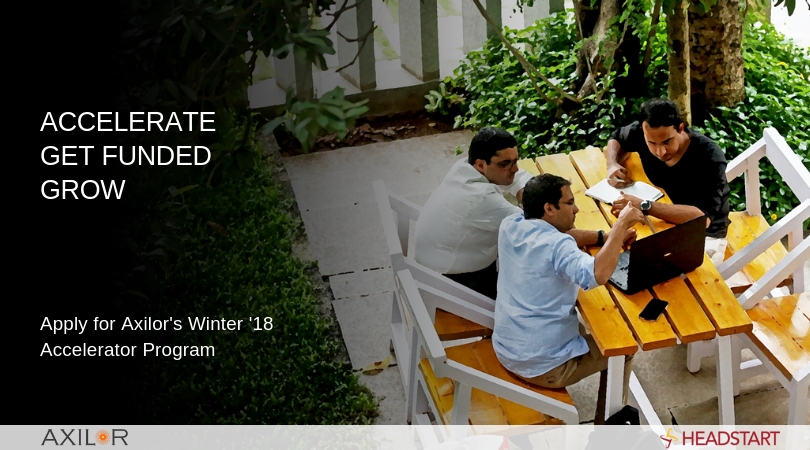
Are you Seed Funding ready?
Headstart Network Foundation
September 7, 2018 6:34 AM
Headstart Network Foundation and Axilor Ventures have been working together to help accelerate startups in India. Here’s a blog post from Ganapathy Venugopal, CEO and Co-founder, Axilor Ventures.
In this first blog on a 2 part series on Seed Funding, I share learnings from helping startups successfully raise funding as part of Axilor’s Accelerator program, the applications for which is currently open.


Of all the things that make a startup journey exciting, fundraising will possibly be at the bottom of the pack in most founders’ list. It is tiring, uncertain and most first time founders are ill prepared for it. Chetan Kulkarni, founder of Vizury and resident advisor at Axilor, compared fund-raise to filling fuel – you need to know exactly how far your next stop is and plan to have enough fuel in the tank to last the journey, and a little more. It is an apt metaphor. And even more relevant for seed funding which is like filling fuel for the first time – there is a lot you don’t know yet!
When it comes to seed funding, there are two questions founders need good answers for. First, “Are you Ready for Seed Funding?” (this blog) and second, “How to Raise Seed Funding?” (the next blog). We have worked with more than 50 startups in the last one year through our Accelerator Program and more than 2/3rd of them raised their seed funding/scaled– for a startup that means your chances of raising seed funding with Axilor Accelerator program is 10x better than without. As part of this journey, we have learnt a lot on what it takes to raise seed funding and what do seed investors look for. Much of these learnings will benefit first-time founders.
A good point to start will be to dispel some common notions held by founders. Many of these are uninformed and come in the way of a successful fundraising. Thinking through these carefully also means you will be funding ready. There are many but the focus is on the top 5 that we see most common among founders.
1. “We have spent a lot of time building a great product. We have one large customer who is currently piloting it. We are looking to raise seed funding to scale now.” Signing up a large customer is a good start but not adequate. At the seed stage, some early evidence of repeatable and inexpensive customer acquisition process is a key expectation. So if you are a B2B startup, having proof of a customer willing to use is good. But you also need proof that what you have built is valuable (core to your customer need), they are willing to pay (they have written a cheque) and you have figured out a quick, repeatable way to sell (a good pipeline of pilots/deployments).
2. “We are already live and have good traction. We are currently doing an MRR of Rs.Xx lacs (if it is an enterprise startup) or we have an active user base of nK (if it is a consumer startup).” Early revenues or growth are good but often misleading. More than early traction, the key questions to get answers for will be “Who is your customer?” and hence, “What is the market size?”. As counter-intuitive as it may sound, good answers to these two questions may trump the traction criteria. So if there is a hiring-tech startup A is focused on SMBs in India and is at Rs 10 lac MRR v/s hiring-tech startup B focused on SMBs in the US and is at Rs 3 lac MRR, Startup B may be considered more ready than A because it has a richer customer base and larger potential market size. If you are a B2C startup, then in addition to adding some early users, you should be able to establish that there is some evidence of deep engagement and/or being at an inflection of viral growth. There is nothing more exciting to an investor to invest in a startup at an interesting inflection of growth.
3. “Our product is quite unique and differentiated.” Most founders believe that they are unique and differentiated. But the true test is whether the user perceives them as differentiated and valuable. While it is easy to launch and find some early users, finding what is your unique offering is always a process of discovery. This discovery is aided by listening to what your customers are saying. One of our startups always used to pitch their offering (teleradiology) as replacing a radiologist but the growth used to be tepid. But they saw their conversion double when they changed their offering as access to a qualified panel of specialists which is better than most large hospitals. In both cases, the offering was the same. But the second one offered what a small hospital or diagnostic centre truly wanted to compete better – expertise and speed, thus obviating the need for second opinions and better patient experience.
4. “What do you mean by a narrative? We are what we do.” Most founders find it easy to talk about what they do. This existential approach works well to communicate passion but it falls short when it comes to fund-raise. The narrative is one of the most over-looked aspects by founders when it comes to fundraise. This is not so much a deficiency as it is a blind spot – a tunnel vision resulting from an excessive focus on the product or the technology. But having the right narrative offers an almost unfair advantage. That said, this is also one of the most difficult bridges to cross. A good narrative transcends the immediate idea, product, technology, features and communicates the true difference you bring in and hence the business opportunity. It is one thing to call your startup ‘an app that allows people to share interesting stuff in vernacular’ and quite another to ‘build a social network to empower the 500mn who don’t speak English’.
5. “We track only growth metrics. Besides, this is only a seed round – would not a basic set of growth metrics be enough?”. There are two important notions of metrics. One, that metrics don’t matter much for seed investors. Nothing could be farther from the truth in India. When large VCs write seed cheques the bet sometimes is on the macro themes. As a result, the diligence may be a little less onerous on the business, but they still look for metrics on growth, cost of acquisition, monetisation. Most seed funds certainly look for far more validation.
The second notion is that the only growth metrics matter. While it is certainly important, it is not adequate. The metric that matters is the one that is providing early evidence of product market fit – it could be average time spent or what percentage of transactions are going through your platform. So knowing what metrics matter for your business and having some evidence of improving trend puts you in a good position. At the Axilor program, the session on “Metrics that Matter” by Nitin Sharma, ex Lightbox Partner and a resident advisor, is one of the most popular sessions. It is also invariably one where founders fundamentally change the way they think about what to measure.
Finally, some thoughts on fund-raiser itself. Many founders treat the fund-raise readiness as a separate problem. That approach can be frustrating. The good news is that in the early stages, there is hardly any conflict between what is good for business and what is good for fundraise. Both of these priorities are very well aligned. So fixing these will help you present a more confident story of your startup. And as our experience at Axilor shows, these can be fixed quickly with the right focus, goals and support.
In theory, the formula for seed funding goes like this – a large market opportunity X potential to be a category leader X founding team with right background X early evidence of product market fit (note these are multiplicative rather than additive). But as the famous Yogi Berra quote goes – in theory, there is not much difference between theory and practice but in practice there is! And knowing the nuances of how this works in practice is key to fund-raising success. It is always useful to remember what seed investors are looking for in you. Seed funds are betting on you to get to a Series A whereas the VC funds are betting on you to scale and hence absorb more capital. So, in addition to ticking all the boxes on your funding readiness, you need to answer these questions for your investors. That will be covered in the next blog, “How to Raise Seed Funding?”
